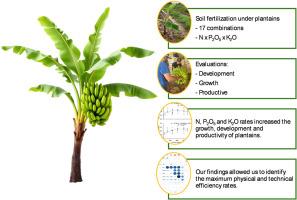Development and productivity of ‘Terra Maranhão’ plantains influenced by soil fertilization with nitrogen, phosphorus and potassium
IF 8.4
引用次数: 0
Abstract
Plantains are plants of the genus Musa that require substantial amounts of nutrients applied to the soil, highlighting nitrogen (N), phosphorus (P2O5) and potassium (K2O) as being the most critical. This nutrient demand is often unmet in the acidic soil, highly weathered and presenting low natural fertility. Mineral fertilizers are used to correct deficiencies in soil nutrients and enhance crop productivity. Establishing optimal application rates is essential for the success and sustainability of agricultural systems. This research aimed to evaluate the effects of different fertilization rates of N, P2O5 and K2O on the parameters of growth, development, and productivity of ‘Terra Maranhão’ plantain in Brazil. Seventeen combinations of N (0–700 kg ha−1), P2O5 (0–450 kg ha−1) and K2O (0–1370 kg ha−1) were assessed. The design used was randomized blocks with three replications, each plot consisting of 10 plants. Data were subjected to regression analysis, which tested polynomial and linear univariate models. Fertilization with N, P2O5 and K2O significantly influenced the growth, development and productivity parameters, fitting quadratic or linear univariate models. The quadratic models showed maximum physical efficiency rates for the productivity parameters ranging from 430 to 513 kg ha−1 of N (p < 0.001), 281–285 kg ha−1 of P2O5 (p < 0.001), and 723–868 kg ha−1 of K2O (p = 0.001 to p < 0.001), resulting in a bunch mass of 45.9–46.2 kg, average hand mass of 4.12–4.13 kg, and productivity of 61–62 t ha−1. Plants with a pseudostem circumference of 95 cm, pseudostem height of 4.5 m and 16 leaves per plant presented productivity greater than 65 t ha−1. These findings contribute to the optimization of the ‘Terra Maranhão’ plantain production system, providing recommendations for fertilization rates of N, P2O5 and K2O that maximize productivity in a shorter production cycle.

氮、磷、钾对‘Terra maranh o’大蕉发育和生产力的影响
车前草是芭蕉属植物,需要大量的养分施用于土壤,其中氮(N)、磷(P2O5)和钾(K2O)是最关键的。这种养分需求在酸性土壤中往往得不到满足,因为酸性土壤风化严重,自然肥力较低。矿质肥料用于纠正土壤养分不足,提高作物生产力。确定最佳施用量对农业系统的成功和可持续性至关重要。本研究旨在评价不同施氮量、P2O5和K2O对巴西‘Terra maranh’大蕉生长发育和生产力参数的影响。对N (0 ~ 700 kg ha−1)、P2O5 (0 ~ 450 kg ha−1)和K2O (0 ~ 1370 kg ha−1)的17种组合进行了评估。采用随机区组设计,每组3个重复,每个小区包括10株植物。数据进行回归分析,检验多项式和线性单变量模型。N、P2O5和K2O对生长发育和生产力参数影响显著,拟合二次或线性单变量模型。二次模型显示,在N (p < 0.001)、P2O5 (p < 0.001)和K2O (p = 0.001 ~ p < 0.001)的生产参数范围内,最大物理效率为430 ~ 513 kg ha - 1, P2O5 (p < 0.001)和K2O (p = 0.001 ~ p < 0.001),导致束质量为45.9 ~ 46.2 kg,平均手质量为4.12 ~ 4.13 kg,生产率为61 ~ 62 t ha - 1。假茎周长为95 cm、假茎高为4.5 m、单株16片叶片的植株产量大于65 tha−1。这些发现有助于“Terra maranh o”大蕉生产系统的优化,为在较短的生产周期内实现产量最大化提供N、P2O5和K2O的施肥量建议。
本文章由计算机程序翻译,如有差异,请以英文原文为准。
求助全文
约1分钟内获得全文
求助全文

 求助内容:
求助内容: 应助结果提醒方式:
应助结果提醒方式:


